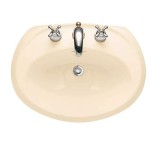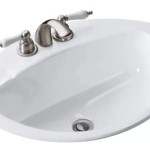Can I Paint My Bathroom Sink Faucet? A Guide to Refinishing Your Fixture
The aesthetic appeal of a bathroom can be significantly impacted by the condition and style of its fixtures. Over time, bathroom sink faucets can become worn, outdated, or simply clash with a new design scheme. Replacing a faucet can be costly and involve plumbing expertise. Painting the existing faucet presents a potential alternative, offering a more economical and DIY-friendly solution. However, the feasibility and longevity of painted faucets depend on several factors, including the faucet material, the type of paint used, and the preparation and application techniques employed.
This article aims to provide a comprehensive overview of painting bathroom sink faucets, outlining the necessary steps, materials, and considerations to achieve a satisfactory and durable finish. It will delve into the types of paints best suited for this application, the importance of proper surface preparation, and the protective measures needed to ensure the paint adheres well and withstands the daily rigors of a bathroom environment.
Understanding the Considerations Before Painting
Before embarking on a faucet painting project, a thorough assessment of the fixture's condition and material is crucial. Not all faucets are suitable candidates for painting. Severely corroded or damaged faucets may be beyond the point where paint can provide a lasting improvement. The material of the faucet also plays a significant role in paint adhesion. Common faucet materials include brass, chrome, stainless steel, and zinc alloys. Each material requires specific preparation and potentially different types of primers and paints.
Chrome faucets, in particular, pose a challenge due to their exceptionally smooth and non-porous surface. Paint struggles to adhere to chrome without extensive surface preparation, which often involves aggressive sanding or the use of specialized bonding primers. Brass and zinc alloy faucets, while generally more receptive to paint, still require meticulous cleaning and priming to ensure a durable finish. The age and existing finish of the faucet also matter. Older faucets may have multiple layers of coatings that need to be removed, while newer faucets might have protective sealants that impede paint adhesion.
Furthermore, consider the amount of use the faucet receives. High-traffic bathrooms, such as those used by families or in commercial settings, will subject the painted faucet to more wear and tear. Frequent handling, exposure to water and cleaning products, and the potential for abrasion all contribute to the likelihood of the paint chipping or peeling. In such cases, a higher-quality paint and a more robust sealing process are essential.
Essential Steps for Preparing the Faucet for Painting
Proper preparation is the cornerstone of a successful faucet painting project. Skimping on these initial steps will inevitably lead to premature paint failure and a disappointing outcome. The process typically involves several key stages:
Disassembly: Begin by carefully disassembling the faucet. Remove handles, aerators, and any other detachable parts. This simplifies the painting process and ensures that all surfaces are adequately coated. Take photographs or make detailed notes of the assembly process to facilitate reassembly later.
Cleaning: Thoroughly clean the faucet with a degreasing cleaner to remove any dirt, grime, soap scum, or mineral deposits. Abrasive cleaners can be used judiciously to tackle stubborn stains, but avoid excessive scrubbing that could damage the faucet's surface. Rinse the faucet thoroughly with clean water and allow it to dry completely.
Sanding: Sanding is crucial for creating a textured surface that paint can grip onto. Use a fine-grit sandpaper (around 220-grit) to lightly scuff the entire surface of the faucet. For chrome faucets, a more aggressive sanding approach with a coarser grit (around 120-grit) may be necessary. However, exercise caution to avoid scratching the underlying metal excessively. After sanding, remove all sanding dust with a tack cloth or a damp cloth.
Priming: Applying a primer is essential for promoting paint adhesion and providing a uniform base for the topcoat. Choose a primer specifically designed for metal surfaces. Epoxy primers or bonding primers are particularly effective for chrome and other difficult-to-paint materials. Apply the primer in thin, even coats, following the manufacturer's instructions. Allow the primer to dry completely before proceeding to the next step. Some primers may require light sanding after drying to create an even smoother surface for the paint.
Masking: Use painter's tape to carefully mask off any areas of the faucet that you do not want to paint, such as the threads for the aerator or the internal components. This will ensure clean lines and prevent paint from interfering with the faucet's functionality.
Selecting the Right Paint and Application Techniques
Choosing the appropriate paint is another critical factor in determining the success of the project. Not all paints are created equal, and some are better suited for metal surfaces and wet environments than others. Several types of paint are commonly used for painting faucets, each with its own advantages and disadvantages:
Epoxy Paint: Epoxy paint offers exceptional durability and resistance to water, chemicals, and abrasion. It forms a hard, protective coating that is ideal for high-use faucets. However, epoxy paint can be more challenging to apply and may require specialized equipment, such as a spray gun. It also tends to be more expensive than other types of paint. Two-part epoxy paints require mixing a resin and a hardener, adding another layer of complexity to the application process.
Acrylic Latex Paint: Acrylic latex paint is a water-based option that is easy to apply and clean up. It is also readily available in a wide range of colors and finishes. However, acrylic latex paint is not as durable as epoxy paint and may be more susceptible to chipping and peeling, especially in a wet environment. For best results, choose a high-quality acrylic latex paint specifically formulated for metal surfaces.
Spray Paint: Spray paint provides a smooth, even finish and is relatively easy to apply, especially for intricate faucet designs. Choose a spray paint specifically designed for metal surfaces and that is resistant to moisture and chemicals. Apply the paint in thin, even coats, holding the can approximately 8-10 inches from the faucet. Avoid applying thick coats, as this can lead to drips and runs. Allow each coat to dry completely before applying the next.
Application Techniques: Regardless of the type of paint chosen, proper application techniques are essential for achieving a professional-looking finish. Apply the paint in thin, even coats, using a brush, roller, or spray gun, depending on the type of paint and the size and complexity of the faucet. Avoid applying thick coats, as this can lead to drips, runs, and uneven drying. Allow each coat to dry completely before applying the next. Follow the manufacturer's instructions for drying times and any specific application recommendations.
After applying the final coat of paint, allow it to dry completely, following the manufacturer's recommended drying time. This is crucial for ensuring that the paint hardens properly and develops its full durability. Once the paint is completely dry, carefully remove the masking tape and reassemble the faucet.
Protecting the Painted Finish: Sealants and Maintenance
To further enhance the durability and longevity of the painted finish, applying a clear sealant is highly recommended. A sealant provides an extra layer of protection against water, chemicals, and abrasion, helping to prevent chipping and peeling. Several types of sealants are available, including acrylic, polyurethane, and epoxy sealants.
Acrylic Sealants: Acrylic sealants are water-based and easy to apply. They provide a good level of protection against water and UV damage. However, they are not as durable as polyurethane or epoxy sealants and may require more frequent reapplication.
Polyurethane Sealants: Polyurethane sealants offer excellent durability and resistance to water, chemicals, and abrasion. They form a hard, protective coating that is ideal for high-use faucets. However, polyurethane sealants can be more challenging to apply and may require multiple coats for optimal protection.
Epoxy Sealants: Similar to epoxy paints, epoxy sealants offer the highest level of durability and resistance. They form an incredibly hard and protective coating that is virtually impenetrable to water and chemicals. However, epoxy sealants can be expensive and may require specialized equipment for application.
Apply the sealant in thin, even coats, following the manufacturer's instructions. Allow each coat to dry completely before applying the next. After applying the final coat of sealant, allow it to cure completely before using the faucet. Regular cleaning and maintenance are also essential for preserving the painted finish. Avoid using abrasive cleaners or harsh chemicals, as these can damage the paint and sealant. Instead, use a mild soap and water to clean the faucet regularly. Wipe the faucet dry after each use to prevent water spots and mineral deposits from forming.

The Best Way To Spray Paint A Faucet Average But Inspired

The Best Way To Spray Paint A Faucet Average But Inspired

Crafty Allie Diy Spray Paint Your Bathroom Faucet

Can You Spray Paint Bathroom Faucets Oh Yes Karins Kottage

Painted Bathroom Faucets Shower Enclosure Addicted 2 Decorating

Painted Faucetsdiy Show Off Diy Decorating And Home Improvement Blog

Can You Spray Paint Bathroom Faucets Oh Yes Karins Kottage

Spray Painted Faucets Easy Diy Bathroom Vanity Makeover Part 1

The Best Way To Spray Paint A Faucet Average But Inspired

Transform Your Bathroom With Sink Paint The Honeycomb Home







